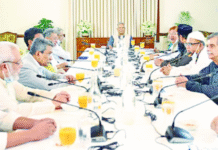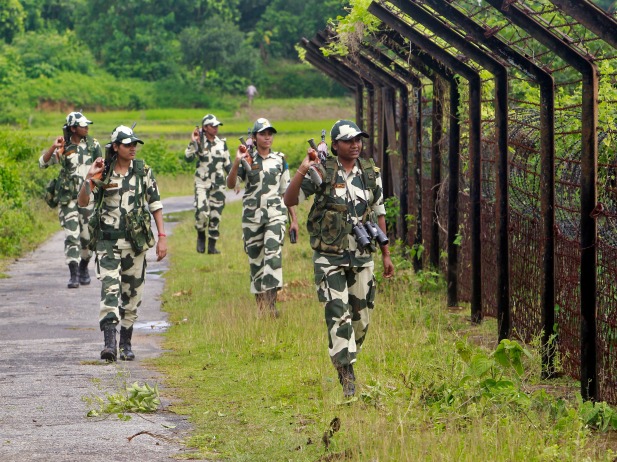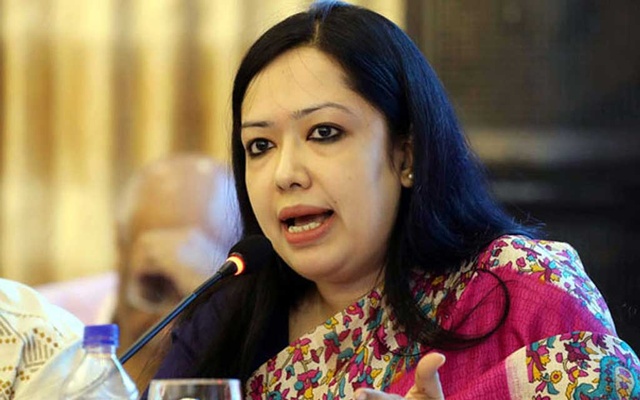
Last update on: Fri Apr 4, 2025 07:29 AM

US President Donald Trump yesterday stood in the White House Rose Garden, pointing to an oversized placard with details of levies he is set to impose on imports from America’s trading partners. The reality quickly set in: Trump dramatically ratcheted up his trade war. And Bangladesh is among those countries whose labour-intensive export industries will receive a heavy blow.
Under Trump’s “reciprocal tariffs” policy, Bangladeshi exports to the United States now face a 37 percent levy — a move that threatens to strain trade with its largest single-country export market.
Trump has targeted nations, accusing them of putting disproportionate barriers to American exports. He imposed 10 percent universal tariffs on all US trade partners as well as additional, heavier duties on 60 countries he deemed the “worst offenders” of unfair trade practices. The universal tariffs will start on Saturday before the country-specific, higher reciprocal tariff takes effect from April 9.

The penalties unleashed turbulence across world markets and drew condemnation from many countries facing the end of an era of trade liberalisation that has shaped the global order for decades.
While significant for Bangladesh, this move aligns with similarly stringent tariffs across the region, suggesting a broader strategic intent rather than targeting Bangladesh alone.
Notably, Vietnam, a close competitor for Bangladesh in the international garment trade, faces an even higher tariff of 46 percent, despite the Southeast Asian nation’s proactive attempts to mitigate tariff threats by cutting levies on American goods and pledging to increase imports of significant US products.
However, this offers little comfort to Bangladesh. Its economy, heavily reliant on exports to the United States, particularly garments, now faces headwinds.
“For countries like Bangladesh and other developing countries, this shift poses significant challenges, as they may face tougher economic conditions under such an uncertain regime,” Professor Selim Raihan, executive director of the South Asian Network on Economic Modeling, said.
Industry experts in Dhaka fear the sharp increase in tariffs could erode Bangladesh’s competitive edge, potentially diverting US buyers to other countries. Still, the US will remain Bangladesh’s largest single-country export destination, with apparel constituting about 90 percent of total exports to American markets.
Bangladesh’s exports to the US rose 1.1 percent year-on-year to $8.4 billion in 2024, driven largely by the country’s dominant garment sector, according to data from the United States Trade Representative.
Bangladesh’s imports from the US totalled $2.2 billion in 2024, a 1.5 percent decrease from the previous year. As a result, the US trade deficit with Bangladesh widened to $6.2 billion — a figure that determined the new tariff rate.
WHAT SHOULD BANGLADESH DO?
“The immediate priority is damage control, as the reciprocal tariffs are already in effect, with no time allowed for a smooth transition. Even goods currently en route to the US will be subject to the new tariffs, raising the critical question: Who will bear the cost?” said Zahid Hussain, a former lead economist of the World Bank’s Dhaka office.
Bangladesh’s strategy should aim to shift the tariff burden onto buyers, according to Hussain. “A key advantage is that buyers have limited alternatives, as many of our competitors face similar or even higher reciprocal tariffs. However, fierce competition among [local] sellers poses a significant challenge, enabling wholesale buyers like Walmart and Target to pass the tariff costs onto us,” he said.
To counter this, it is crucial for sellers to collectively agree not to accept a reduction in prices to offset the tariff. The relevant association must closely monitor renegotiated prices and enforce penalties for non-compliance with this agreed position, Hussain said.
“Additionally, we should explore the possibility of qualifying our exports for duty exemptions by emphasising their status as low-priced essential products.”
TRADE REALIGNMENT
Analysts point out this escalation is part of broader regional trade realignment, as neighbouring India and Pakistan also face reciprocal tariffs of 27 percent and 29 percent, respectively. Cambodia faces the highest tariff at 49 percent closely followed by other Asian countries.
China, the primary focus of Trump’s trade agenda, will face a 34 percent reciprocal tariff, which stacks atop an existing 20 percent fentanyl-related duty and separate levies on categories like solar panels. That brings the effective tariff rate on many Chinese goods to well above 50 percent.
India said it was studying the impact of the new tariff and vowed to push for a trade deal this year, signalling a conciliatory tone despite failing to get relief from Trump’s trade policy.
New Delhi’s response came hours after Trump announced the drastic tariffs that piled more stress on an ailing global economy and sent world stock markets and oil prices tumbling.
India’s export competitiveness would be less impacted than that of key rivals due to its position in the middle of the tariff rates, said the country’s industry bodies, Assocham and the Federation of Indian Export Organisations.
The tariffs would remain in effect until Trump determined that the “threat posed by the trade deficit and underlying non-reciprocal treatment is satisfied, resolved, or mitigated,” the White House said.
The US has a trade deficit of $46 billion with India.
But the reciprocal tariff will pile pressure on Indian Prime Minister Narendra Modi, who counts himself among Trump’s friends, to find ways to get India off the hook.
Last week, Reuters reported that New Delhi is open to cutting tariffs on US imports worth $23 billion to mitigate the impact on its exports in sectors like gems and jewellery, pharmaceuticals, and auto parts.
Modi’s administration has taken a number of steps to win over Trump by lowering tariffs on high-end bikes, bourbon and dropping a tax on digital services that affected US tech giants.
Before the reciprocal announcement, the simple average US tariff rates were at 3.3 percent, compared with India’s 17 percent, the White House said.
Ajay Sahai, director general at the Federation of India Export Organisations, said the reciprocal tariff on India was lower than that of key competitors like Vietnam and Bangladesh, which could help Indian apparel and footwear sectors.
These tariffs signal a calculated shift in US trade policy aimed at addressing “trade imbalances and reshaping international trade practices”.
Economists and trade groups have voiced concerns that these moves may invite retaliatory tariffs, potentially igniting trade conflicts and raising costs for businesses and consumers.
Washington’s friends and foes united in criticism of measures they fear will deal a devastating blow to global trade. China, the world’s No. 2 economy, vowed countermeasures, as did the European Union.
“The consequences will be dire for millions of people around the globe,” EU chief Ursula von der Leyen said, adding the 27-member bloc was preparing to hit back if talks with Washington failed.
US Treasury Chief Scott Bessent earlier warned any retaliatory moves would only lead to escalation.
Among close US allies, the European Union was targeted with a 20 percent rate, Japan with 24 percent, South Korea with 25 percent and Taiwan with 32 percent. Even some tiny territories and uninhabited islands in the Antarctic were hit by tariffs, according to a list posted by the White House on X.
“This is not the act of a friend,” said Prime Minister Anthony Albanese of Australia, a nation often described as America’s “deputy sheriff” in Asia.
“The [Trump] administration’s tariffs have no basis in logic and they go against the basis of our two nations’ partnership.”









